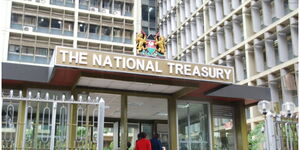Rarieda MP Otiende Amollo has said that any intended transfer of the Public Seal to the head of Public Service, Felix Koskei's office, must have been unconstitutional.
The Attorney General has traditionally been the custodian of the Public Seal, which is the official emblem used to represent the government and its authority.
There have been media reports that the Public Seal was moved to Koskei's office through secret legislation.
Amollo, who is a lawyer, on Wednesday, May 21, said that the intrigue surrounding the transfer of the Public Seal through secret legislation lacked a legal basis.
While slamming an article by the Standard newspaper that accused President William Ruto of a power grab through the discreet transfer, Amollo said Section 28 of the Office of the Attorney General Act, which hands the custody of the Public Seal to the AG, remains intact.
“This is inaccurate reporting. There is no legal basis upon which the Public Seal can be removed from the AG. We removed the intended mischief and Section 28 of The Act remains intact,” he said.
This is despite reports confirming the National Government Administration Laws (Amendment) Act, 2023, which reassigned the custody of the Public Seal to the Head of Public Service, had been passed by the National Assembly.
Also, Government Spokesperson Isaac Mwaura recently confirmed that the custody of the Public Seal was under the office of the Head of Public Service. Koskei's docket is under the Executive arm of government.
“The Head of Public Service is the number one public servant in this country. He holds the Public Seal, executes the directives of the President and oversees the daily operations of government,” Mwaura said.
The Public Seal plays a crucial role as a national symbol and a tool for authenticating official government documents. The Seal consists of the coat of arms of Kenya set on a grayscale background featuring two lions, a symbol of protection, holding spears and a traditional East African shield.
It serves as a mark of authenticity for key government documents, ensuring their legitimacy and official status. It is affixed to documents to confirm that they have been issued or approved by the state.
As a national symbol, it represents the authority of the Kenyan state and is a formal marker of sovereignty.
It also serves as a safeguard against unauthorised actions, ensuring a constitutional check on executive power. The custodian, traditionally the AG, oversees the use of the seal to prevent misuse or unauthorised actions.
In light of the recent developments, critics argued that the transfer of the seal to Koskei represented a scheme by Ruto to avoid accountability that would give rise to shoddy deals and graft.
This, they claimed, would happen because Koskei’s office is not under any checks and balances, thus limiting oversight accorded to his office. Consequently, this could result in rampant legal misuse and chaos.
Aside from that, those against the transfer said it was a case of executive overreach, one that could potentially undermine the Attorney General’s role as the chief legal advisor of the government.
However, the government, while assuring that due process was followed in the transfer of custody, argued that centralising authority in the President’s office would streamline decision-making and improve efficiency.












